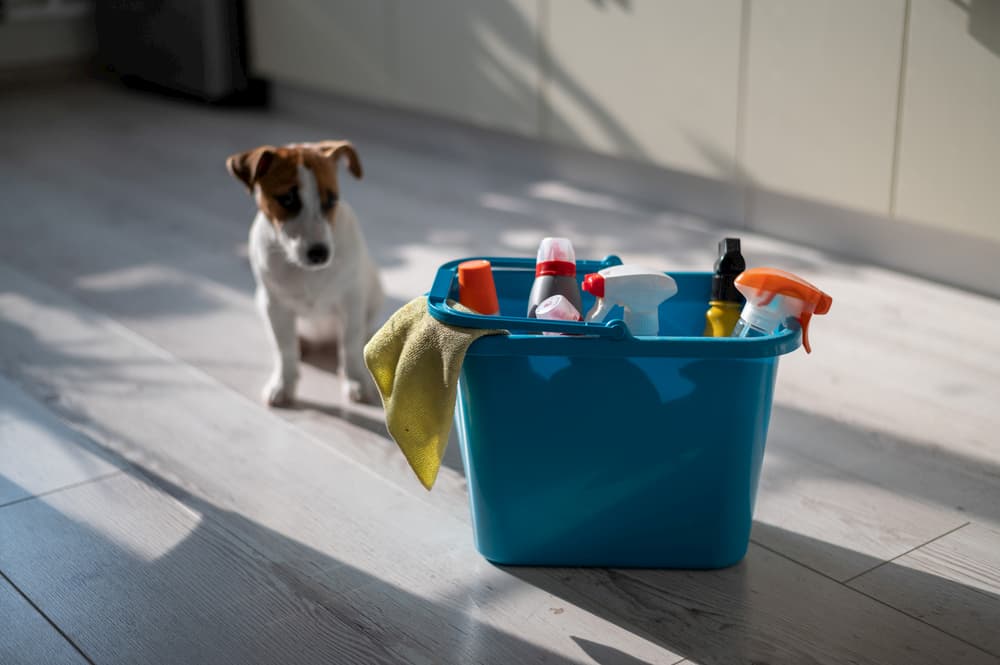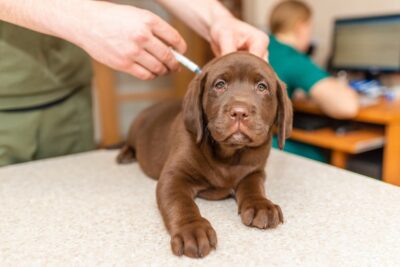Puppy Proofing 101: Complete Guide to a Safer Home

Bringing home a new puppy is an exciting time for the entire family. Parents of human children know about the need to baby proof the home, but learning how to puppy proof your house is just as important for pet parents.
Fueled by curiosity, that sweet little puppy can get into more trouble than you might think. Puppy proofing not only keeps your puppy safe, but it can protect your house and belongings too.
“Puppies get into everything because they don’t know what’s okay and what’s not okay to chew or play with,” says Dr. Gary Weitzman, CEO of the San Diego Humane Society. “Never leave anything within your puppy’s reach, including shoes, purses, phones, cords, kids’ toys and basically anything chewable. Some things are especially dangerous for puppies.”
According to Dr. Weitzman, some of the most dangerous items in your house include:
- Antifreeze
- Batteries (especially tiny button batteries found in kids toys and greeting cards with sound)
- Coins (especially pennies)
- Contents of trash cans (use lids or stow cans under cabinets)
- Toxic foods
- Disposable razors
- Human medications
- Household cleaners
- Paints and solvents
- Rodent poison
- Slug and snail bait
- Toxic house plants
If you think your puppy might have ingested something dangerous, call your own veterinarian (during regular business hours). If the incident happens at night or over the weekend, call an emergency vet hospital or a pet poison hotline.
“The ASPCA Animal Poison Control Center is open 24 hours a day, 365 days a year,” Dr. Weitzman says. “You’ll be charged a fee, but it’ll be the best money you’ve ever spent.” The ASPCA Poison Control hotline is 888-426-4435.
Puppy Proofing Considerations for First-Time Pet Parents

One of the best ways to puppy proof is to work in one room at a time. To help identify potential hazards in each room, think like a puppy by getting down on your hands and knees on the floor. When you look at your home from a puppy’s point of view, you see things you might not have noticed before.
“Pay attention to the dangerous objects your puppy could chew on or get tangled in, small spaces he may get stuck in, or areas where he may fall and injure himself,” says Dr. Weitzman.
The areas of your home that are generally the most dangerous for new puppies include the kitchen, bathrooms, office, living room, garage and yard.
How to Puppy Proof Your Home
Taking a few precautions can go a long way toward keeping your new puppy safe. The general idea is to block access to anything dangerous your pup might lick, chew, swallow, fall off or fall into. Consider these common household hazards:
Kitchen

The kitchen is a treasure trove of potentially hazardous items and situations for your puppy. Pay attention to these areas:
Trash can: One of the biggest hazards in the kitchen is the trash can. Use a can with a lid or stow the can inside a cabinet to keep your pup from getting into spoiled food, cooked bones, coffee grinds, aluminum foil and other dangerous garbage.
Countertops: If your puppy is tall or growing fast, the countertops might not be a safe place to keep food or sharp knives. Make sure your puppy cannot reach or jump onto the countertops.
Lower cabinets: If your pup is particularly determined, consider using child locks on cabinets, especially those that contain household cleaners, dishwasher detergent and other chemicals.
Plastic bags: “Plastic bags left around in the kitchen pose a suffocation risk,” Dr. Weitzman says. “Puppies find them fun to play with because of the noise they make and they often smell like food from the grocery store.” However, if your puppy’s head becomes trapped in a bag, this could interfere with their ability to breathe.
Bathrooms
Puppies love to explore the bathroom with all of its smells and fun toys (hello, toilet paper!). Puppy proof your bathroom by focusing on the following:
Bathroom cleaners: Store all cleaning solutions and chemicals inside a cabinet. You also might want to stow the toilet bowl brush and plunger in a cabinet to keep your pup from knocking them over or chewing on them (yuck!).
Toilets: Surprisingly, toilets are a drowning risk for very small puppies. If they fall in, they might not be able to climb back up the slick sides. Keep the lid down to keep pups out, and don’t use toilet tank drop-in tablets in case you forget to close the lid and your puppy drinks from the bowl.
Human medications: Don’t forget to move human medications, lotions and creams out of your puppy’s reach.
Office

A home office is filled with things that are potentially dangerous should a puppy decide to chew or swallow them. Watch out for these hazards:
General office supplies: Pens, markers, erasers, push pins, tacks, paperclips, tape and glue can all pose a problem for puppies. If your new canine chews these or swallows them, it can lead to potential toxicity or an intestinal blockage. Keep these items stored high on a desk or shelf, where your puppy can’t grab them.
Electrical cords: Pups can become tangled in a nest of electrical cords, or even strangle themselves, so keep cords wrapped or tucked behind office furniture. Chewing on electrical cords can also pose an electrocution risk.
Living Room
Your family probably spends most of the time in the living room, and your puppy will too. Just make sure to make the following adjustments to keep your dog safe:
Cords and blinds: Cords are also problematic in the living room, but the same solution works here (tuck them behind the television or furniture). Puppies can become tangled in window blind cords, too, so tie or tuck these up high where your puppy can’t reach.
Television remotes: Keep your TV remote on a bookshelf or your mantle as these are irresistible to puppies. Chewing on a remote can cause cuts in the mouth or exposure to dangerous batteries.
Fireplaces: “If you have a fireplace, make sure your puppy can’t reach it,” Dr. Weitzman says. Actual flames are of course an obvious hazard, but puppies can also get sick from eating ashes or chewing on logs. Use a sturdy fireplace screen to keep your puppy safe.
Garage and Basement

The garage and basement can be full of dangers for a puppy, especially when it’s used to store hazardous materials. Be aware of the following potential issues:
Poisonous substances: Household items like plant fertilizer, weed killer, slug and snail bait, rodent poisons and paint are all extremely dangerous. Additionally, antifreeze can be lethal to animals in small amounts. It’s best to keep your puppy out of the garage or basement unless you are right there to closely supervise.
Carbon monoxide: “It’s important to know that dogs are more susceptible to carbon monoxide poisoning than their owners,” Dr. Weitzman says. “Wait to start your car until the last possible moment and keep the garage door open to avoid carbon monoxide buildup.”
Yard
Puppies spend a lot of time in the yard, but make sure yours is a safe haven rather than a danger zone by puppy-proofing these outdoor areas:
Fences and gates: Check all gates and fences for small spaces or gaps that a puppy might try to squeeze through. Ensure that all latches to gates are closed when letting your puppy out in the yard.
Fertilizers and pesticides: Avoid using harmful fertilizers, slug and snail bait, ant bait or rodenticides in your yard. Curious puppies may eat these items or chew on grass that has been fertilized, leading to potential toxicity.
Mushrooms and plants: Do a periodic sweep of the yard to look for mushrooms and pull them before your puppy can eat them (some mushrooms are toxic to dogs). Double check that none of the plants or flowers in your yard are toxic to dogs (the ASPCA maintains a comprehensive list).
Pools and hot tubs: “If you have a pool, hot tub, or pond, restrict access as these can be very dangerous for a puppy who has not developed his swimming skills,” Dr. Weitzman says. Use fences or covers for pools and hot tubs and block off ponds or other bodies of water with a fence or x-pen (portable wire pen).
How to Puppy Proof an Apartment

Puppy proofing an apartment is much like puppy proofing a house, with some additional considerations. Here are special puppy-proofing considerations for apartment dwellers:
Balconies: If you live in a high-rise apartment building, make sure your puppy cannot climb over or through balcony railings. Tiny puppies should not be left alone on balconies as they can be snatched by large birds of prey like hawks and owls.
Windows: Be sure to keep your windows closed—a curious puppy leaning against a window screen can pop it out and fall through the window. Falls through windows are more dangerous from the second floor or higher, but even on the first floor, puppies can push out a screen and run away.
Puppy Proofing in Every Season
Holidays add extra dangers for puppies, including foods and decorations. Here’s how to keep your home safe during all the festive fun:
Holiday foods: Dr. Weitzman says it’s best to avoid giving your puppy holiday foods like turkey and other indulgent dishes, which may contain ingredients that could make your puppy sick. Be especially careful not to feed your puppy rich, greasy foods, like poultry skin, fatty meat, gravy or anything with lots of butter and sweets (especially chocolate). Also avoid cooked bones, which can splinter and pierce the intestinal tract. Talk to your guests to make sure they aren’t sneaking your puppy food that could make her sick.
Decorations: “During Christmas, keep ornaments and tinsel, which can be a choking hazard, on high branches,” Dr. Weitzman says. “Cords from lights should be taped down or otherwise secured to prevent puppies from chewing on them. Don’t let your puppy drink water from the base of a live tree as it may contain bacteria.”
Holiday plants: Certain holiday plants are toxic or irritating to dogs. Keep the following out of your puppy’s reach: amaryllis, Christmas cactus, Christmas rose, evergreens, holly, ivy, juniper, all lilies, mistletoe and poinsettias.
Post Puppyhood Safety
How long you’ll need to stay on top of puppy proofing depends on your puppy’s personality.
“It might be many months—even a year or more—before your puppy is reliably housetrained and able to roam free in all areas of your home without chewing something up,” Dr. Weitzman says. “Be patient. All puppies become dogs and most eventually learn what it takes to live with humans safely.”









